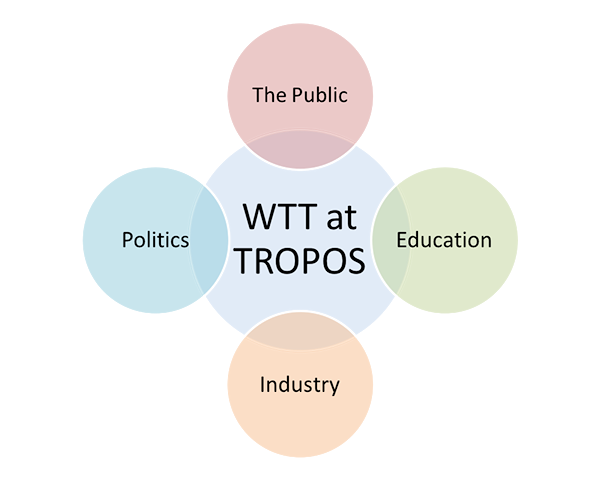Mission statement for knowledge and technology transfer
The Leibniz Institute for Tropospheric Research (TROPOS) pursues theoria cum praxi science for the benefit of society in accordance with the principles of the Leibniz Association. Knowledge and technology transfer (WTT) is an important task in this respect because scientific knowledge and research-based technological developments must be communicated to other areas of society through suitable transfer instruments in order to have an impact in these areas.
TROPOS therefore understands WTT to include all activities which, in this context, affect specific target groups beyond science and which generally require target group-specific translations or even services from a mediating entity.
Target groups can be various social areas and groups, e.g. the general public, political decision-makers, interest groups, students, private companies and many others.
As diverse as the target groups are, are the applied transfer instruments, which can range from classical press and media work, which also includes Social Media platforms to committee work, policy advice, non-university educational offers, to patents and spin-offs.
Explicitly excluded from the WTT area at TROPOS are all activities concerning research and academic teaching itself, e.g. lectures, publications, scientific reports, etc.. Even if it cannot be ruled out that transfer benefits can also be achieved in this way, this is nevertheless regarded as an actual core task of the Institute, whose most important sense is not the transfer but the advancement of scientific knowledge and the training of young scientists.
In this sense, WTT at TROPOS is understood and practiced as an interface between science and society. Meeting the increasing quantitative and qualitative demands of society on science is seen as an important task. Therefore, the further development of existing transfer instruments and the development of new approaches is becoming increasingly important.
Transfer areas and instruments at TROPOS
WTT takes place at TROPOS in four large areas, as shown in Figure 1. The transitions between the areas are partially blurred and some of the transfer instruments outlined below can have an effect in different areas without being explicitly mentioned here.

Figure 1: The four areas of the WTT at the TROPOS
In public
In the public sphere, broad segments of civil society are generally addressed. It covers all activities aimed at interested citizens. The aim is to communicate concrete research contents and results, as well as the culture of science in general. The transfer effect can unfold through a deeper understanding of the concrete contents and the scientific approaches and thinking.
The area of public relations has already been considerably augmented at TROPOS. Important transfer instruments that are regularly used are the following:
- Press releases about current work
- Interviews in print media, radio and television
- Journalistic articles in print media, radio and television
- Public website with current information
- Organisation of and participation in public information and discussion events (e.g. Long Night of Sciences, Week of the Environment)
- Social Media (Instagram, LinkedIn, Mastodon and Bluesky)
Education
WTT in the field of education has similar goals and effects as in the public sector but differs slightly by having more concrete target groups. Transfer instruments in this area:
- Student internships
- Special Learning Achievements (BELL)
- Project offers for school classes and kindergarten groups
- Target group-specific educational events (e.g. Girls Day)
- Popular Science Contributions
- Citizen science
Politics
The policy area includes all forms of policy advice and policy-relevant committee work. Target groups are political decision-makers, interest groups or other political actors. Transfer instruments have an impact in this area, for example, if political discourse on relevant topics is supported or research findings are incorporated into legislation or even open up new fields of political action. The following transfer instruments exist in this area at TROPOS:
- Direct dialogue with political decision-makers (e.g. Leibniz in the Bundestag)
- Work in committees and consortia on air quality and climate (e.g. KdRL, DKK)
- Participation in and organisation of expert workshops with political actors (e.g. VDI EFAC)
Industry
The field of technology is mainly addressed to the private sector and industry. Technology transfer takes place when technological developments from research are commercially exploited or research knowledge flows into entrepreneurial innovation. This area at TROPOS is currently only slightly expanded. In principle, the following transfer instruments exist here:
- Cooperation with small and medium-sized enterprises and industry
- Work in committees and consortia on technological aspects (e.g. KdRL)
- Licensing and patents for technological developments
- Spin-offs

